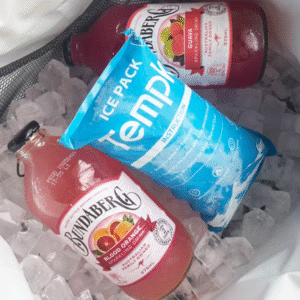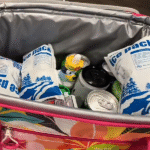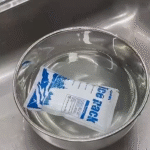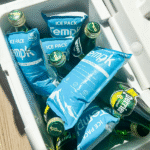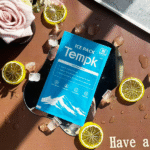Are Biodegradable Dry Ice Blocks Best for Fish Shipping?
Biodegradable dry ice blocks for fish are transforming seafood logistics. These blocks leverage carbon dioxide’s ultra cold sublimation at −78.5 °C to keep fish frozen without puddles, while biodegradable films reduce plastic waste. By integrating recycled CO₂ and plant based casings, they offer reliable, moisture free cooling for 24–72 hours. This guide explores why this innovation matters, wie man es richtig benutzt, Und was 2025 trends mean for your business. You’ll learn how these blocks compare to gel packs, how to size them for different shipments, and how biodegradable sensors and smart packaging will shape the future.
How biodegradable dry ice blocks keep fish ultra cold without leaks? – using long lasting sublimation and biodegradable casings.
What materials make a biodegradable dry ice block for fish eco friendly? – plant based films, compostable resins, recycled CO₂ and breathable vent designs.
How to select, activate and pack a biodegradable dry ice block for fish shipments? – step by step instructions, sizing rules and safety tips.
Was 2025 innovations are changing fish packaging? – biodegradable sensors, IoT-Überwachung, hybrid PCM systems and regulatory trends.
Why these blocks align with sustainability goals and consumer expectations? – benefits for carbon footprint reduction, cost savings and compliance.
How Does a Biodegradable Dry Ice Block Keep Fish Ultra Cold and Dry?
It works by combining dry ice’s ultra low temperature with a biodegradable casing. Dry ice sublimates directly from solid CO₂ to gas at −78.5 °C, absorbing 571 kJ of heat per kilogram and leaving no water behind. A biodegradable dry ice block for fish encases these pellets within a paper, cellulose or plant based polymer film that breaks down naturally. This design ensures fish stay frozen for 24–72 hours without moisture that could compromise texture or safety. The vents built into the casing allow CO₂ gas to escape, preventing pressure build up and satisfying hazardous material regulations.
In depth explanation: Im Gegensatz zu Gelpackungen, die schmelzen 0 °C and release water, a biodegradable dry ice block for fish maintains sub zero temperatures throughout the shipment. Each block contains cells filled with solid CO₂ that sublimate, drawing heat away from fish fillets while generating dry CO₂ gas. The outer casing uses biodegradable films—often derived from paper pulp, cellulose acetate or compostable polymers—that degrade naturally after use. This eliminates microplastics and reduces landfill waste. Ventilation channels or perforations ensure the CO₂ gas does not build up inside the packaging, which could otherwise cause swelling or ruptures. With proper insulation, these blocks maintain fish at or below −20 °C for two to three days, outperforming traditional ice and gel packs.
Selecting the Right Biodegradable Dry Ice Block Size
Choosing the correct block size is essential for maintaining temperature without waste. A general rule is to match the weight of dry ice to the weight of the fish product; Zum Beispiel, 1 kg of fish requires roughly 1 kg of dry ice to stay frozen for 24 Std.. Thicker blocks (18 mm or 24 mm) provide longer cooling durations, bis zu 48 oder 72 hours respectively. Always pre chill your container and fish to reduce initial thermal load, and use vented, insulated containers to slow sublimation. A table below summarizes block thickness and appropriate shipment duration.
| Block Thickness | Typische Dauer | Bester Anwendungsfall | Praktischer Nutzen |
| 12 mm | Bis zu 24 Std. | Overnight fish deliveries or short haul shipments | Leicht, less CO₂ required |
| 18 mm | Etwa 48 Std. | Domestic exports and longer regional routes | Balances weight and duration |
| 24 mm | Bis zu 72 Std. | International seafood shipments or remote destinations | Maximum frozen time, minimizes spoilage |
Practical Tips and Safety Guidelines
Hydrate and freeze properly: For sheet style biodegradable blocks, immerse the sheet in warm water and massage it until the cells expand, then freeze for at least 24 Std.. For pre formed blocks, pre chilling and freezing at −20 °C ensures maximum sublimation energy.
Schützen Sie sich: Always wear insulated gloves and goggles when handling dry ice to avoid frostbite.
Belüftung sicherstellen: Use vented lids or leave a small gap so CO₂ gas can escape, preventing pressure build up or container rupture.
Pre chill and insulate: Chilling fish and the container before packing reduces sublimation rate. Insulated foam, vacuum panels or reflective liners cut sublimation loss to 3 % per day.
Follow regulations: Label packages with “Dry Ice” or “Carbon Dioxide, Solide,” include the net weight and UN 1845 code, and comply with IATA and DOT quantity limits.
Verantwortungsbewusst entsorgen: Nach Lieferung, allow remaining dry ice to sublimate in a well ventilated area. Recycle or compost the biodegradable film according to local guidelines.
Real Case: A seafood exporter in the Pacific Northwest installed a CO₂ capture unit at a nearby brewery to produce dry ice locally. By coupling locally sourced dry ice blocks with biodegradable casings and upgraded insulation, the company maintained fish at −30 °C for 60 hours while cutting dry ice usage by 30 %. This approach reduced emissions and improved cost efficiency.
What Makes Biodegradable Dry Ice Blocks Eco Friendly?
They use plant based materials and repurposed CO₂ to eliminate plastic waste. The outer layer of a biodegradable dry ice block for fish often consists of paper, cellulose or compostable polymers that decompose naturally. Some manufacturers use biodegradable grades of expandable polystyrene (EPS) that degrade 92 % in four years in wet landfill conditions. The CO₂ inside comes from industrial processes such as bioethanol or ammonia plants, converting waste gas into refrigerant. Zusammen, these innovations reduce reliance on virgin plastics, lower greenhouse gas emissions and support circular economy goals.
Erweiterte Erklärung: Traditional fish packaging relies on rigid foam coolers and gel packs made from petroleum based plastics that persist for centuries. Im Gegensatz, biodegradable dry ice blocks use renewable or recyclable materials. Biodegradable films made from cellulose or PLA (Polymilchsäure) provide barrier protection while breaking down into harmless compounds over time. Some producers employ biodegradable EPS resin that microbes can digest in active landfills, reducing long term environmental impact. These blocks often incorporate plant based coatings that slow sublimation and reduce frost buildup, improving performance. By sourcing CO₂ from renewable feedstocks or waste capture, manufacturers further cut carbon footprints.
Environmental Benefits and Cost Advantages
Biodegradable dry ice blocks offer multiple environmental and economic benefits:
Reduced plastic waste: The biodegradable casing eliminates plastic liners and microplastics that harm oceans.
Repurposed CO₂: Dry ice production often uses CO₂ captured from fermentation or ammonia plants, turning industrial emissions into a useful refrigerant.
Water conservation: Im Gegensatz zu Gelpackungen, dry ice production requires little water, preserving resources.
Lower carbon emissions: Locally sourcing CO₂ and reducing dry ice quantity through hybrid systems can cut emissions by 30 %.
Kosteneinsparungen: Lightweight biodegradable blocks reduce dimensional weight and shipping costs. Reusable or compostable versions decrease reorder frequency and waste management fees.
Improved brand perception: Consumers increasingly value sustainable packaging; using biodegradable dry ice signals environmental responsibility.
| Nutzen | Data/Description | Praktische Bedeutung |
| Plastic waste reduction | Biodegradable casings replace petroleum based plastics, Eliminierung der mikroplastischen Verschmutzung | Protects oceans and aligns with consumer expectations |
| Repurposed CO₂ | CO₂ sourced from industrial waste streams lowers reliance on fossil fuels | Reduces carbon footprint, qualifies for CO₂ neutral certifications |
| Water conservation | Dry ice production uses minimal water compared to gel packs | Saves resources and prevents water waste |
| Kosteneffizienz | Lightweight design and reusability cut shipping and waste management costs | Improves profitability and supply chain efficiency |
| Consumer appeal | 43 % of consumers consider packaging sustainability when purchasing seafood | Enhances brand loyalty and meets regulatory requirements |
Practical Scenarios and Recommendations
Frozen seafood export: Use biodegradable dry ice blocks with thick insulation for long haul shipments. Blocks maintain fish at −50 °C for 48 hours and appeal to eco conscious buyers.
Domestic fish delivery: For regional markets, combine medium thickness blocks with PCMs for extended cooling and cost savings.
E commerce meal kits: Offer subscription boxes with smaller biodegradable blocks for frozen components; pair them with wool liners for chilled items.
Fallstudie: A fishery shipping tuna internationally switched to biodegradable dry ice blocks and paper based films. The fish arrived at −50 °C for 48 Std., and customers appreciated the plastic free packaging. This transition also reduced the fishery’s packaging waste by 40 % within a year.
How to Select, Activate and Pack a Biodegradable Dry Ice Block for Fish Shipments
Follow a step by step process for optimal cooling and safety. The preparation and packing of a biodegradable dry ice block for fish are critical to achieving long lasting freezing. Erste, match the block’s weight to the fish weight (1:1 ratio) and choose thickness based on transit time. Nächste, hydrate the polymer cells (for sheet style blocks) and freeze them until they reach at least −20 °C. Pre chill the fish and container to reduce thermal load. Beim Packen, place the block around or on top of the fish, leaving space for CO₂ gas to vent. Endlich, label the package with the dry ice weight and UN 1845 code, and use vented, Isolierte Behälter.
Erweiterte Anleitung: The success of a biodegradable dry ice block for fish depends on proper hydration (gegebenenfalls) und Gefrieren. Hydration activates the super absorbent polymer cells and improves flexibility. Freezing at the lowest possible temperature increases the energy stored in the block. Pre chilling fish reduces the initial heat load and extends the block’s cooling duration. Beim Packen, place the block or sheet with the fabric or biodegradable side facing the product to prevent direct contact with extreme cold and to absorb moisture. Ensure ventilation channels are unobstructed to allow CO₂ escape, preventing container rupture. Für mehrtägige Sendungen, layer blocks above and below the fish or combine them with phase change materials (PCMs) to buffer temperature swings.
Step By Step Table
| Schritt | Aktion | Warum ist es wichtig | Ergebnis |
| 1 | Determine required duration and weight | Align block size with shipment time (12 mm für 24 H, 18 mm für 48 H, 24 mm für 72 H) and match CO₂ weight to fish weight | Ensures sufficient cooling without waste |
| 2 | Hydrate polymer cells (if using sheets) | Activates absorbent cells, enhancing flexibility and sublimation control | Prevents cracking and improves block contact |
| 3 | Freeze fully at ≤ −20 °C | Maximizes energy storage and sublimation capacity | Provides longer cooling duration |
| 4 | Pre chill fish and container | Reduces initial thermal load | Extends block’s performance and limits sublimation loss |
| 5 | Pack with vent space | Position block around or above fish; leave ventilation pathways for CO₂ gas | Avoids pressure build up and ensures even cooling |
| 6 | Label and comply | Mark with “Dry Ice,” net weight and UN 1845; follow IATA/DOT rules | Ensures legal compliance and safety |
Helpful Tips and Advice
Use hybrid systems: Combining biodegradable dry ice blocks with PCMs can reduce dry ice consumption by 40 % and extend shipping windows.
Upgrade -Isolierung: Vacuum insulation panels and reflective liners cut sublimation loss from 8 % Zu 3 % per day.
Überwachen Sie die Temperatur: Integrate low power sensors or data loggers to track temperature and location; alerts allow corrective action when excursions occur.
Educate recipients: Provide instructions for safe handling and disposal; encourage consumers to compost or recycle the casing.
Test pack out: Conduct small trial shipments to fine tune block thickness and insulation; adjust based on real world temperature data.
Beispiel: A meal kit company shipping regional seafood used 18 mm biodegradable blocks for frozen fish and wool liners for chilled vegetables. Sensors revealed that CO₂ levels remained safe and fish stayed below −20 °C for 36 Std.. Customer complaints about soggy packaging dropped significantly, and the company saved 20 % on refrigerant costs by using hybrid cooling systems.
2025 Innovations and Trends in Biodegradable Dry Ice for Seafood
Trendübersicht
The cold chain industry is experiencing rapid innovation. In 2025, biodegradable sensors and smart packaging are moving from prototypes to commercial products. Flexible sensors printed on molded fiber trays or PLA films monitor oxygen, CO₂ and humidity, extending fish shelf life from seven to fourteen days. Active layers infused with natural extracts like green tea and silver nanoparticles are integrated into biodegradable trays to slow microbial growth. Regulations such as the EU Packaging and Packaging Waste Regulation (Pp) require all food packaging to be reusable or recyclable by 2030 and mandate digital IDs for traceability. In North America, laws prohibit hazardous substances in food packaging and require traceability records for high risk foods.
Latest Progress at a Glance
Biodegradable sensors: Researchers developed stretchable, battery free sensor systems that monitor gas changes in fish packaging and double shelf life.
Active antimicrobial layers: Incorporating oxygen scavengers and anti fungal compounds into biodegradable trays reduces spoilage for high risk foods like seafood.
IoT enabled dry ice packs: Low power sensors embedded in blocks transmit temperature and location data, enabling real time tracking and regulatory compliance.
Hybrid PCM systems: Combining dry ice with phase change materials stabilizes temperature and reduces total dry ice use.
Nachhaltige CO₂-Beschaffung: CO₂ captured from biogas plants replaces fossil derived carbon, lowering the carbon footprint of dry ice production.
Market Insights and Consumer Trends
Market data reveals growing demand for sustainable packaging. Biodegradable dry ice blocks and sheets are moving from pilot trials to mainstream adoption. Analysts project the global dry ice and alternative refrigerant market to grow from USD 1.54 Milliarden in 2024 to USD 2.73 Milliarden von 2032. At least twelve U.S. states and two territories have enacted bans on expanded polystyrene foam (EPS) by mid 2025, prompting companies to adopt biodegradable alternatives. Consumer surveys show that nearly half of U.S. buyers are extremely concerned about packaging waste. Certifications from the Biodegradable Products Institute (BPI) and Forest Stewardship Council (FSC) help identify truly sustainable packaging. Businesses that embrace biodegradable dry ice blocks can differentiate themselves and capture eco conscious consumers.
Häufig gestellte Fragen
Q1: How long does a biodegradable dry ice block for fish last?
A properly sized block maintains ultra cold temperatures for 24–72 hours, depending on thickness and insulation. Wählen 12 mm for overnight deliveries, 18 mm for 48 hour trips, Und 24 mm for 72 hour shipments.
Q2: Can biodegradable dry ice blocks be reused?
NEIN. Sobald das Trockeneis sublimiert ist, the cooling capacity is gone. Jedoch, the biodegradable casing can be composted or recycled according to local guidelines, Abfall reduzieren.
Q3: Are biodegradable dry ice blocks safe for air transport?
Ja, but they are regulated as Class 9 Gefahrstoffe. Packages must display the “Dry Ice” or “Carbon Dioxide, Solid” label, Und 1845 identification and net weight. Ventilation and weight limits must be respected.
Q4: What’s the difference between biodegradable dry ice blocks and gel packs?
Dry ice blocks provide extreme cold (−78.5 °C to −20 °C) for 24–72 hours and leave no moisture. Gel packs maintain 0–5 °C for 12–48 hours, melt into water and are easier to handle but produce plastic waste.
Q5: How do I know if packaging is truly biodegradable?
Look for certifications from the Biodegradable Products Institute (BPI) or the Forest Stewardship Council (FSC). Check whether the outer film and fillers meet compostability standards such as EN 13432 or ASTM D6400.
Zusammenfassung und Empfehlungen
Biodegradable dry ice blocks for fish deliver ultra cold temperatures while reducing plastic waste. They use plant based films or biodegradable EPS resin and repurposed CO₂, offering moisture free cooling for up to 72 Std.. By matching block thickness to transit time and following proper hydration, freezing and packing steps, you can ensure fish arrive frozen and safe. Upgrading insulation, integrating sensors and exploring hybrid PCM systems further enhance performance and sustainability. As regulations tighten and consumers demand greener packaging, adopting biodegradable dry ice blocks positions your business at the forefront of sustainable seafood logistics.
Umsetzbare nächste Schritte
Bewerten Sie Ihre Versandanforderungen: Determine typical transit times and fish weight. Use the sizing table to select appropriate block thickness and quantity.
Invest in sustainable supplies: Source biodegradable dry ice blocks from suppliers that use renewable CO₂ and certified compostable films.
Upgrade -Isolierung: Switch to vacuum panels or recyclable foam to reduce sublimation and weight.
Integrate monitoring: Adopt IoT sensors and digital platforms to track temperature and optimize logistics.
Educate your team and customers: Provide clear handling, ventilation and disposal instructions. Highlight certifications and sustainability benefits to build trust.
Über Tempk
Tempk is a leader in cold chain solutions with a focus on sustainability and innovation. Our team combines industry expertise with cutting edge technology to deliver eco friendly refrigerants, including biodegradable dry ice blocks, flexible sheets and hybrid PCM systems. We source CO₂ responsibly and design packaging that meets global safety and environmental standards. Partnering with Tempk means access to knowledgeable consultants, high performance products and a commitment to reducing carbon footprints.
Aufruf zum Handeln: Ready to enhance your fish shipping sustainability? Contact Tempk for a personalized consultation on biodegradable dry ice blocks and other cold chain solutions.






